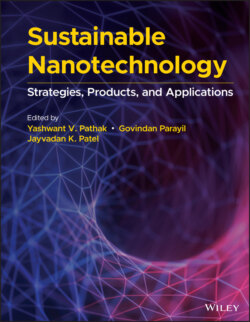Читать книгу Sustainable Nanotechnology - Группа авторов - Страница 71
2.3.11 Regulatory Development
ОглавлениеThe properties of NMs, i.e. extremely high chemical reactivity due to nano size range, large surface area, and narrow size range, make them hazardous to the environment and human health. The therapeutic NMs, which are prepared from all known inert materials, could become penetrable or react with the non‐targeted site and molecule, respectively. On one hand, the toxic manifestation of several NMs is still unknown, and on the other hand, the large‐scale production technology is growing at its peak. The exposure of NMs by such mass production industry can create unprecedented event. To anticipate and minimize unfavorable consequences or unintended consequences and to have future public acceptance of nanotechnology‐based innovations and development, robust regulatory guideline and support are required today.
Appreciable initiatives are taken by different countries/states till date to regulate nanotechnology, NMs, and the production thereof, including Europe, United States, Asia, and all over the world.
The European Commission has actively reacted on the issue, and under its guidance during 2011–2013, a detailed tactical research outline was published by the associates of the European Union (EU) NanoSafety Cluster with a strategic goal for future exploration on the secure utilization and safeguarded applications of all formulated NMs. The timeline for this documentation was kept for 10 future years starting from 2015. The document focused on delivering a key action ahead in the development of safe and sustainable NMs. Shortly after, the regulatory body of the European Chemicals Agency (ECHA) developed massive advice on the regulatory risk assessment under the European Community Regulation on chemicals and their safe use (REACH) for NMs and published it in April 2012. The European Union funded project BILAT USA 4.0 is one of the milestone events in the development of regulatory guidelines globally. In this event, one of the major concerns was the cooperation for nanosafety between the United States and EU. The result of the event was the identification of several prospective tools and five components for dedicated and accurate evaluations of human and environmental hazards caused by nanotechnology that includes improved testing assays, pertinent endpoints, technical awareness, risk assessment classification for NMs under development or in usage, and harmonized methods to toxicity evaluation.
The US government has its own initiative for nanotechnology that is active since 2000 called the National Nanotechnology Initiative (NNI). NNI actively looks into all matters concerning the sustainability of NMs. The issues related to EHS implications of NMs are specifically taken care by two different groups, Nanotechnology Environmental and Health Implications (NEHI) and Nanoscale Science, Engineering, and Technology (NSET). The first one is the working group of the Nanoscale Science, and the second one is the subcommittee of the National Science and Technology Council. Under NEHI, the US government has been funding since 2005 for EHS‐related research.
A persistent initiative taken by a conference in 2011 and the result of the conference was establishment of an organization – SNO – as discussed in previous section. The objective of SNO was set to support sustainability in nanotechnologies and support and promote further development of nano‐based formulations, taking into consideration health and environment. The SNO also aimed at the safe use of nanoproducts along with providing support for policy and decision‐making. The establishment of such organization made its impact all over the world.
An organization in Singapore working since 2004 was registered in 2007 as Asia Nano Forum (ANF) society to promote development, awareness, and safety of nanotechnology. One of the objectives of ANF is to encourage and harmonize standardization and well‐being of nanotechnology assessments. Including Singapore, 13 different organizations from Japan, Korea, Malaysia, Australia, Philippines, Taiwan, Thailand, and Vietnam are working under one roof for the sustainable development of nano‐based products. Similarly, in Canada, Switzerland, India, and Australia, several government, individual, and autonomous bodies are working hard to address the issues of development, sustainability, and promotion for end users. Although individual organizations are working in their best possible way, it is the need of the hour to unite all the efforts and to address issues arising in development, sustainability, and promotion for end users. Such united efforts can not only uniformly report on single desk but also minimize the time required for recording unknown toxicity of all NMs and related products.
